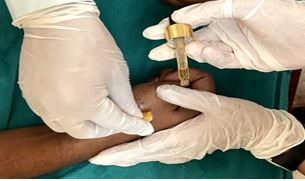Agnikarma with Kshoudra for pain management in De Quervain’s Tenosynovitis - A Single Case Study
Keywords:
De quervain’s tenosynovitis, Kshoudra, Agnikarma, Pain, Case Report.Abstract
De Quervain’s disease, also called gamer’s thumb or mother’s thumb, is a common pathological condition of the wrist. It is commonly known as de quervain’s tenosynovitis a repetitive use of wrist and thumb lead to an inflammation of the Abductor Pollicis Longus and Extensor Pollicis Brevies tendon and all the layers of their associated tendon sheath. The overall incidence of De Quervain’s tenosynovitis is 0.9/1000 person. As per Ayurvedic parameters this condition can be correlated to Snayugata Vikara, which usually presents with Sthambha, Shula, and Kriyavasakthi. According to Ayurveda, Snayugata Vata - Snehana, Upanaha, Agnikarma, and Bandha are the treatments advised. Agnikarma with “Kshoudragudasnehacha” is mentioned is Sandhiasthsirasnayugatavikara. Kshoudra is mentioned as Dahanopakarana for Sira-Snayu-Asthi Sandhi because of penetration to the deeper structures. Till date splinting, systemic anti-inflammatories and corticosteroid injection are the most frequently utilized non-surgical treatment options and if these processes are ineffective, the tendon sheath of the 1st dorsal compartment is surgically released. This study includes a case study of a gentle man of 34 years who gradually developed pain over base of right thumb and wrist joint since 1 month. Agnikarma with Kshoudra was performed in 4 sittings, with a gap of 7 days and assessment was done with subjective and objective parameters. The therapeutic effects of Agnikarma with Kshoudra resulted in relief of pain and muscle spasm, acceleration of healing, promotion of resolution of inflammation and painless range of movement of joint. Kshoudra Agnikarma is cost effective, easy to perform with better aesthetic outcome.
Downloads
References
Deepak Nainwal, R. Arunmozhi. A literature review on de-quervain’s tenosynovitis. Int.J.Adv.Res.2020 8(07) {cited April 2022}, 824-835.
Kuldeep Kumar. Clinico-Anatomical Review of Snayu with special reference to Sprain. IAMJ {online}.2018 May {cited Feb,2020}; 6(5): 1105-09.
Susrutha, Susruthasamhitha, edited by Vaidya Yadavji Trikamji Acharya, Narayan Ram Acharya 'kavyatirtha', Sutrasthana, Ch-12, Ver-3,4,6. Reprint, 2008 ed,Varanasi: Choukhambha Sanskrit Sansthan;p.51-3
Prasanth K S, Ravishankar A G. A Comparative study of Agnikarma with Tapta Kshoudra and Pancadhathu Shalaka in Carpel Tunnel Syndrome. IJAAR. 2017 Jul- Aug{cited July,2021};3(3):677-78















